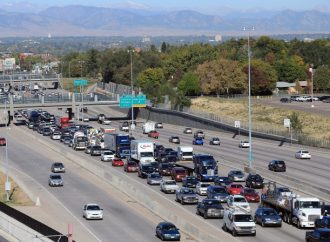Why Colorado Should Not Build High-Speed Rail
- June 23, 2009

The roughly $300 million a year that the Colorado Department of Transportation (CDOT) says it needs to fill the state’s road spending deficit is less than 2 pennies out of each dollar of total state spending.
READ MOREPublic transit is often portrayed as a low-cost, environmentally friendly alternative to auto driving. In fact, transit is much more costly than driving, and requires huge subsidies to attract riders. Moreover, transit systems in the vast majority of American cities use more energy and emit more greenhouse gases than the average car.
For every dollar collected in fares from transit riders, the average transit system in America requires more than $2 from taxpayers for operating subsidies plus more than $1 for capital improvements and maintenance. So it is not surprising that transit systems in Colorado require large subsidies. What may be surprising is that most are far less environmentally friendly than a typical sports utility vehicle.
READ MOREThe Federal Railroad Administration’s high-speed rail plan will cost federal income tax payers $1,000 each— and most of them will never ride it. Colorado isn’t even a part of the plan, but a local proposal for high-speed rail will probably cost $9,000 for every Colorado resident—and most of them will probably never ride it either. High-speed rail won’t relieve congestion, save energy, or reduce greenhouse gas emissions. Colorado should spend its share of federal high-speed rail stimulus funds on safety measures such as grade crossing improvements, not on new trains that will obligate taxpayers to pay billions of dollars in subsidies.
READ MORESmart-growth planning and other land-use restrictions create artificial housing shortages that dramatically reduce housing affordability. Penalties from planning cost Colorado homebuyers $4 billion in 2005, which is far more than any possible benefits from such planning. Local officials should remover barriers to housing construction and find better ways to attain the benefits smart growth is supposed to produce.
READ MORETo promote DRCOG’s vision of a more compact urban area, RTD has plans to build transit-oriented developments— high-density housing combined with retail shops and offi ces—near most of the FasTracks train stations. But the market for such developments is limited. So Denver, Lakewood, and other cities plan to subsidize them using hundreds of millions of dollars of tax-increment fi nancing. In other words, any new property or sales taxes generated by the developments will be used to subsidize the developments. This means other taxpayers will have to pay for schools, fi re, police, and other costs imposed by those developments.
READ MOREFasTracks calls for building six new rail lines and one bus-rapid transit line. Yet RTD’s own data show that the bus line will provide faster, better service at a lower cost. So why build rail when bus is better?
READ MORE